2005 CHEVROLET EXPRESS wheel
[x] Cancel search: wheelPage 1 of 370

Seats and Restraint Systems........................... 1-1
Front Seats
............................................... 1-3
Rear Seats
............................................... 1-6
Safety Belts
.............................................1-10
Child Restraints
.......................................1-31
Airbag System
.........................................1-59
Restraint System Check
............................1-70
Features and Controls..................................... 2-1
Keys
........................................................ 2-2
Doors and Locks
....................................... 2-7
Windows
.................................................2-15
Theft-Deterrent Systems
............................2-18
Starting and Operating Your Vehicle
...........2-18
Mirrors
....................................................2-29
OnStar
®System
......................................2-31
Storage Areas
.........................................2-32
Instrument Panel............................................. 3-1
Instrument Panel Overview
.......................... 3-4
Climate Controls
......................................3-18
Warning Lights, Gages, and Indicators
........3-22
Audio System(s)
.......................................3-39
Driving Your Vehicle....................................... 4-1
Your Driving, the Road, and Your Vehicle
........ 4-2
Towing
...................................................4-34Service and Appearance Care.......................... 5-1
Service
..................................................... 5-3
Fuel
......................................................... 5-5
Checking Things Under the Hood
...............5-10
All-Wheel Drive
........................................5-43
Rear Axle
...............................................5-44
Front Axle
...............................................5-44
Noise Control System
...............................5-45
Bulb Replacement
....................................5-46
Windshield Wiper Blade Replacement
.........5-51
Tires
......................................................5-52
Appearance Care
.....................................5-82
Vehicle Identi�cation
.................................5-91
Electrical System
......................................5-92
Capacities and Speci�cations
.....................5-97
Maintenance Schedule..................................... 6-1
Maintenance Schedule
................................ 6-2
Customer Assistance and Information.............. 7-1
Customer Assistance and Information
........... 7-2
Reporting Safety Defects
...........................7-10
Index.................................................................1
2005 Chevrolet Express Owner ManualM
Page 17 of 370
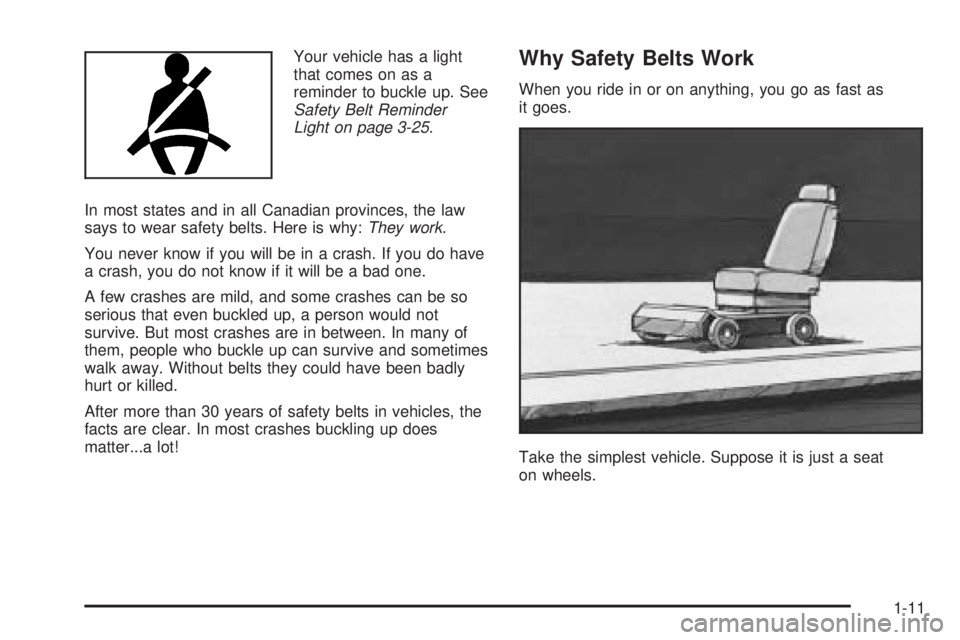
Your vehicle has a light
that comes on as a
reminder to buckle up. See
Safety Belt Reminder
Light on page 3-25.
In most states and in all Canadian provinces, the law
says to wear safety belts. Here is why:They work.
You never know if you will be in a crash. If you do have
a crash, you do not know if it will be a bad one.
A few crashes are mild, and some crashes can be so
serious that even buckled up, a person would not
survive. But most crashes are in between. In many of
them, people who buckle up can survive and sometimes
walk away. Without belts they could have been badly
hurt or killed.
After more than 30 years of safety belts in vehicles, the
facts are clear. In most crashes buckling up does
matter...a lot!Why Safety Belts Work
When you ride in or on anything, you go as fast as
it goes.
Take the simplest vehicle. Suppose it is just a seat
on wheels.
1-11
Page 65 of 370
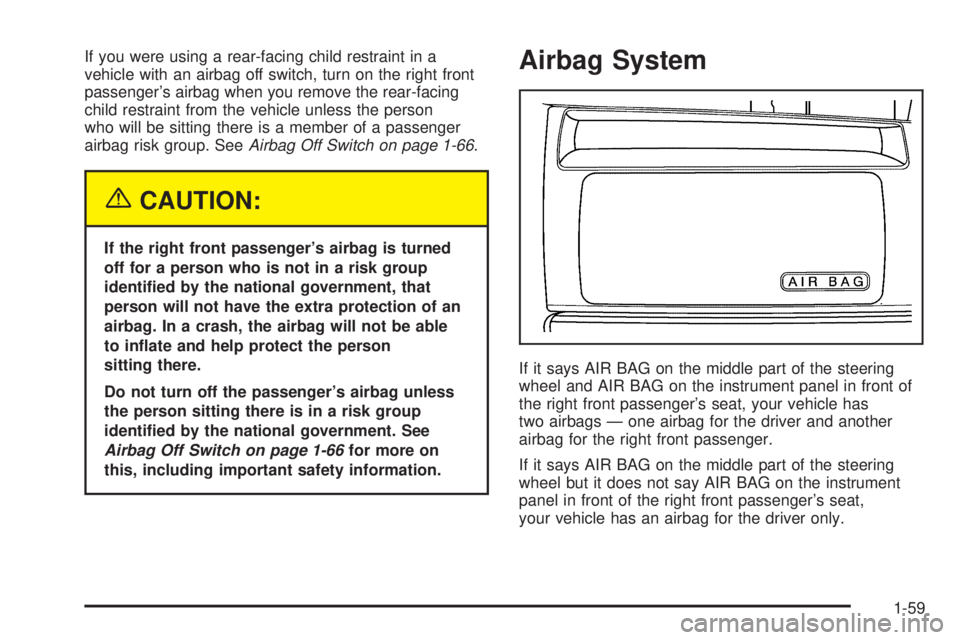
If you were using a rear-facing child restraint in a
vehicle with an airbag off switch, turn on the right front
passenger’s airbag when you remove the rear-facing
child restraint from the vehicle unless the person
who will be sitting there is a member of a passenger
airbag risk group. SeeAirbag Off Switch on page 1-66.
{CAUTION:
If the right front passenger’s airbag is turned
off for a person who is not in a risk group
identi�ed by the national government, that
person will not have the extra protection of an
airbag. In a crash, the airbag will not be able
to in�ate and help protect the person
sitting there.
Do not turn off the passenger’s airbag unless
the person sitting there is in a risk group
identi�ed by the national government. See
Airbag Off Switch on page 1-66for more on
this, including important safety information.
Airbag System
If it says AIR BAG on the middle part of the steering
wheel and AIR BAG on the instrument panel in front of
the right front passenger’s seat, your vehicle has
two airbags — one airbag for the driver and another
airbag for the right front passenger.
If it says AIR BAG on the middle part of the steering
wheel but it does not say AIR BAG on the instrument
panel in front of the right front passenger’s seat,
your vehicle has an airbag for the driver only.
1-59
Page 66 of 370
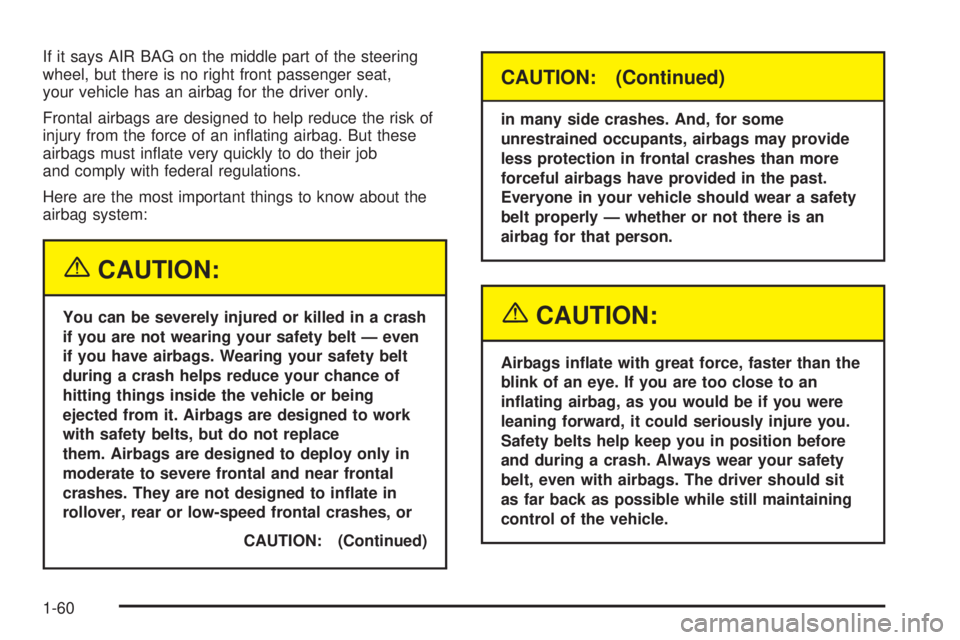
If it says AIR BAG on the middle part of the steering
wheel, but there is no right front passenger seat,
your vehicle has an airbag for the driver only.
Frontal airbags are designed to help reduce the risk of
injury from the force of an in�ating airbag. But these
airbags must in�ate very quickly to do their job
and comply with federal regulations.
Here are the most important things to know about the
airbag system:
{CAUTION:
You can be severely injured or killed in a crash
if you are not wearing your safety belt — even
if you have airbags. Wearing your safety belt
during a crash helps reduce your chance of
hitting things inside the vehicle or being
ejected from it. Airbags are designed to work
with safety belts, but do not replace
them. Airbags are designed to deploy only in
moderate to severe frontal and near frontal
crashes. They are not designed to in�ate in
rollover, rear or low-speed frontal crashes, or
CAUTION: (Continued)
CAUTION: (Continued)
in many side crashes. And, for some
unrestrained occupants, airbags may provide
less protection in frontal crashes than more
forceful airbags have provided in the past.
Everyone in your vehicle should wear a safety
belt properly — whether or not there is an
airbag for that person.
{CAUTION:
Airbags in�ate with great force, faster than the
blink of an eye. If you are too close to an
in�ating airbag, as you would be if you were
leaning forward, it could seriously injure you.
Safety belts help keep you in position before
and during a crash. Always wear your safety
belt, even with airbags. The driver should sit
as far back as possible while still maintaining
control of the vehicle.
1-60
Page 68 of 370
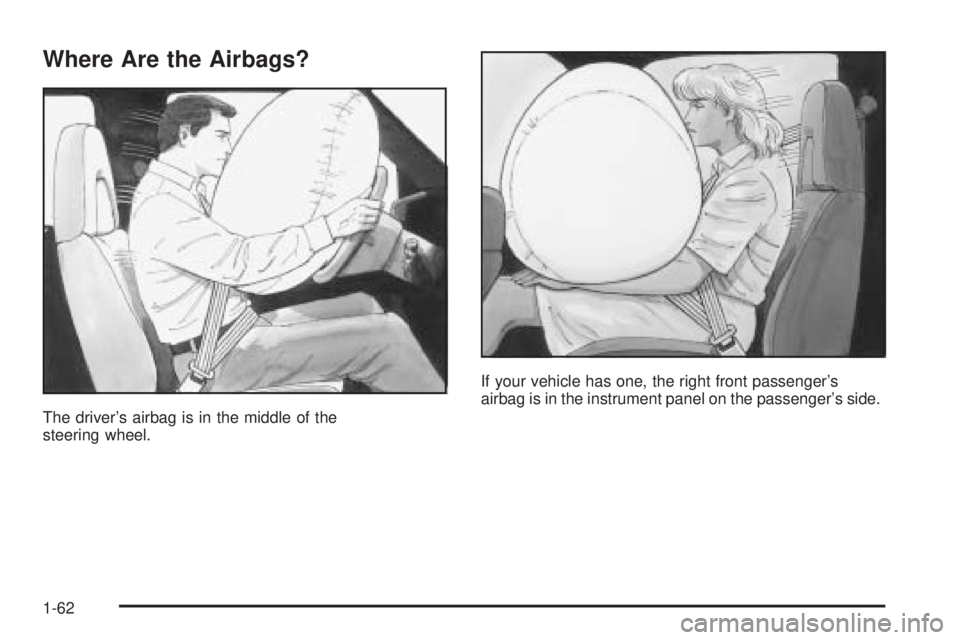
Where Are the Airbags?
The driver’s airbag is in the middle of the
steering wheel.If your vehicle has one, the right front passenger’s
airbag is in the instrument panel on the passenger’s side.
1-62
Page 69 of 370
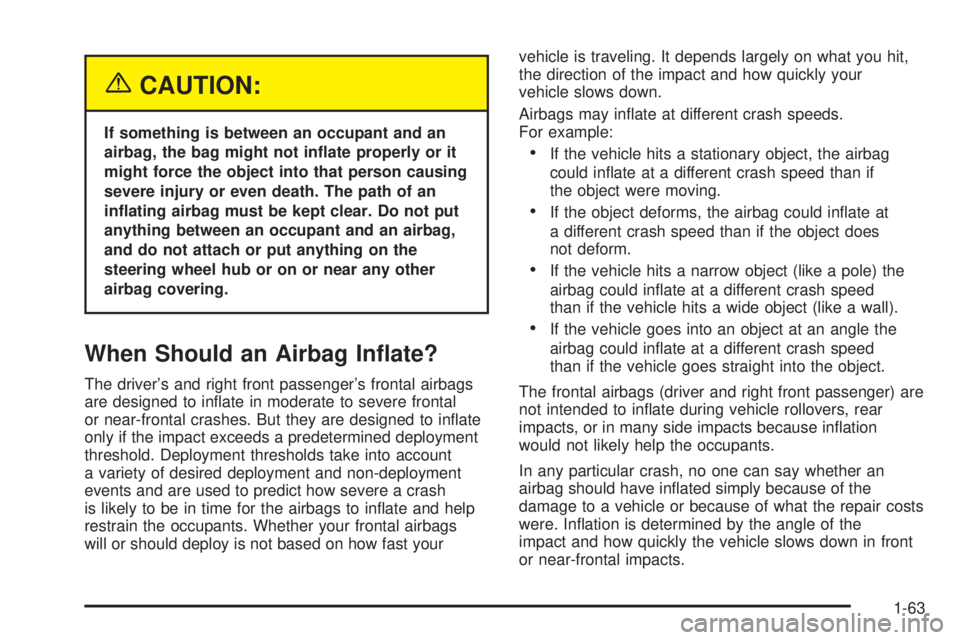
{CAUTION:
If something is between an occupant and an
airbag, the bag might not in�ate properly or it
might force the object into that person causing
severe injury or even death. The path of an
in�ating airbag must be kept clear. Do not put
anything between an occupant and an airbag,
and do not attach or put anything on the
steering wheel hub or on or near any other
airbag covering.
When Should an Airbag In�ate?
The driver’s and right front passenger’s frontal airbags
are designed to in�ate in moderate to severe frontal
or near-frontal crashes. But they are designed to in�ate
only if the impact exceeds a predetermined deployment
threshold. Deployment thresholds take into account
a variety of desired deployment and non-deployment
events and are used to predict how severe a crash
is likely to be in time for the airbags to in�ate and help
restrain the occupants. Whether your frontal airbags
will or should deploy is not based on how fast yourvehicle is traveling. It depends largely on what you hit,
the direction of the impact and how quickly your
vehicle slows down.
Airbags may in�ate at different crash speeds.
For example:
If the vehicle hits a stationary object, the airbag
could in�ate at a different crash speed than if
the object were moving.
If the object deforms, the airbag could in�ate at
a different crash speed than if the object does
not deform.
If the vehicle hits a narrow object (like a pole) the
airbag could in�ate at a different crash speed
than if the vehicle hits a wide object (like a wall).
If the vehicle goes into an object at an angle the
airbag could in�ate at a different crash speed
than if the vehicle goes straight into the object.
The frontal airbags (driver and right front passenger) are
not intended to in�ate during vehicle rollovers, rear
impacts, or in many side impacts because in�ation
would not likely help the occupants.
In any particular crash, no one can say whether an
airbag should have in�ated simply because of the
damage to a vehicle or because of what the repair costs
were. In�ation is determined by the angle of the
impact and how quickly the vehicle slows down in front
or near-frontal impacts.
1-63
Page 70 of 370

If the GVWR (Gross Vehicle Weight Rating) of your
vehicle is 8,500 lb (3 855 kg) or above, your vehicle has
single stage airbags. If the GVWR is below 8,500 lb
(3 855 kg) then your vehicle has dual stage airbags. You
can �nd the GVWR on the certi�cation label on the
rear edge of the driver’s door. SeeLoading Your Vehicle
on page 4-29for more information.
Single Stage Airbags
If your vehicle has frontal airbags with single stage
deployment and your vehicle goes straight into a wall
that does not move or deform, the threshold level
is about 9 to 16 mph (14 to 26 km/h). (The threshold
level can vary, however, with speci�c vehicle design, so
that it can be somewhat above or below this range.)
Dual Stage Airbags
If your vehicle has frontal airbags with dual stage
deployment, the restraint will adjust according to the
crash severity. Your vehicle is equipped with electronic
frontal sensors which help the sensing system
distinguish between a moderate and a more severe
frontal impact. For moderate frontal impacts, these
airbags in�ate at a level less than full deployment. For
more severe frontal impacts, full deployment occurs.If the front of your vehicle goes straight into a wall that
does not move or deform, the threshold level for the
reduced deployment is about 12 to 16 mph
(19 to 26 km/h), and the threshold level for a full
deployment is about 16 to 25 mph (26 to 40 km/h).
(The threshold level can vary, however, with speci�c
vehicle design, so that it can be somewhat above
or below this range.)
Vehicles with dual stage airbags are also equipped with
special sensors which enable the sensing system to
monitor the position of both the driver and passenger
front seats. The seat position sensors provide
information which is used to determine if the airbags
should deploy at a reduced level or at full deployment.
What Makes an Airbag In�ate?
In an impact of sufficient severity, the airbag sensing
system detects that the vehicle is in a crash. The
sensing system triggers a release of gas from the
in�ator, which in�ates the airbag. The in�ator, airbag,
and related hardware are all part of the airbag modules
inside the steering wheel and in the instrument panel
in front of the right front passenger.
1-64
Page 71 of 370
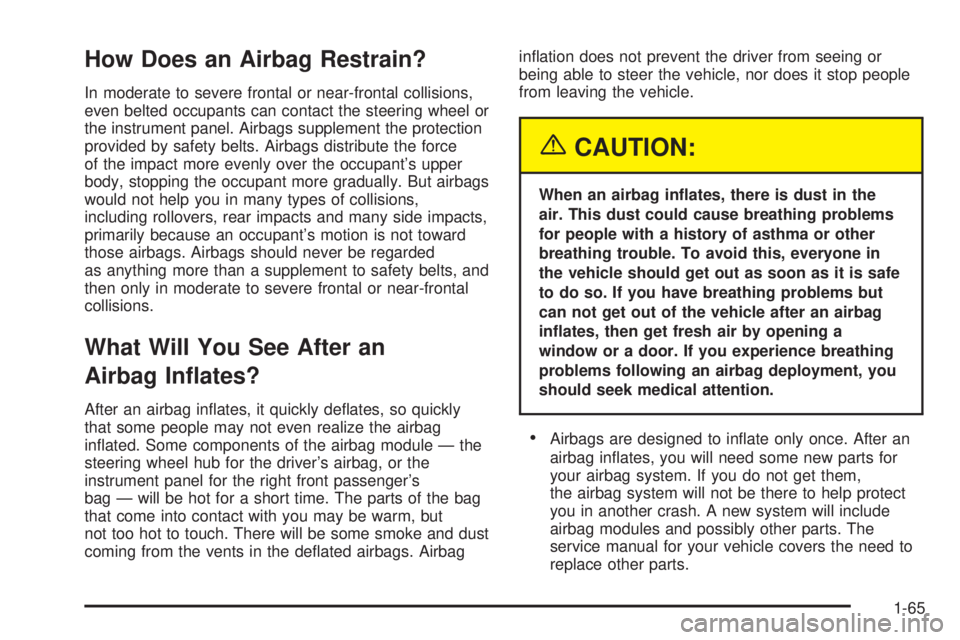
How Does an Airbag Restrain?
In moderate to severe frontal or near-frontal collisions,
even belted occupants can contact the steering wheel or
the instrument panel. Airbags supplement the protection
provided by safety belts. Airbags distribute the force
of the impact more evenly over the occupant’s upper
body, stopping the occupant more gradually. But airbags
would not help you in many types of collisions,
including rollovers, rear impacts and many side impacts,
primarily because an occupant’s motion is not toward
those airbags. Airbags should never be regarded
as anything more than a supplement to safety belts, and
then only in moderate to severe frontal or near-frontal
collisions.
What Will You See After an
Airbag In�ates?
After an airbag in�ates, it quickly de�ates, so quickly
that some people may not even realize the airbag
in�ated. Some components of the airbag module — the
steering wheel hub for the driver’s airbag, or the
instrument panel for the right front passenger’s
bag — will be hot for a short time. The parts of the bag
that come into contact with you may be warm, but
not too hot to touch. There will be some smoke and dust
coming from the vents in the de�ated airbags. Airbagin�ation does not prevent the driver from seeing or
being able to steer the vehicle, nor does it stop people
from leaving the vehicle.
{CAUTION:
When an airbag in�ates, there is dust in the
air. This dust could cause breathing problems
for people with a history of asthma or other
breathing trouble. To avoid this, everyone in
the vehicle should get out as soon as it is safe
to do so. If you have breathing problems but
can not get out of the vehicle after an airbag
in�ates, then get fresh air by opening a
window or a door. If you experience breathing
problems following an airbag deployment, you
should seek medical attention.
Airbags are designed to in�ate only once. After an
airbag in�ates, you will need some new parts for
your airbag system. If you do not get them,
the airbag system will not be there to help protect
you in another crash. A new system will include
airbag modules and possibly other parts. The
service manual for your vehicle covers the need to
replace other parts.
1-65